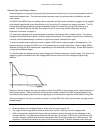
Tsunami MP.11 Antenna Installation
Copyright © 2006 Proxim Wireless Corporation. All rights reserved. 14
CAUTION!
• The cable must be secured along the complete distance between attachment points. No part of the
antenna cable should be allowed to hang free. This is particularly important for outdoor cable parts.
• The antenna cable and cable connectors are not designed to withstand excessive force:
º Do not use the connectors as ‘cable grips’ to pull cable through raceways or conduits.
º Do not use the cable connector to support the weight of the cable during or after installation.
º Do not use any tool to tighten the connectors.
• Always seal the connectors using weatherproofing tape.
• Avoid any water or moisture entering the cable as that impacts the performance of the wireless link.
• Prior to sealing the outdoor connectors and permanently securing the cable to the wall with cable ties
and wall hooks, verify whether the installation and all components functions properly.
OUTDOOR LINK INSTALLATION
The outdoor installation of the link (point-to-point or point-to-multipoint) requires the following:
• An antenna or unit with an integrated antenna
• A low-loss antenna cable (available in four lengths)(not for unit with integrated antenna)
• Antenna mast or wall bracket for the antenna / unit
• A grounding system that meets the requirements described in “Grounding the Antenna” on page 19
• Waterproofing of all connections
Note: All outdoor cable connectors must be sealed with weatherproofing stretch tape to make the connectors
permanently waterproof. See “Sealing the Cable Connectors” on page 18.
DANGER! For your own safety, the antenna mast and the grounding system should be installed only by
experienced installation professionals who are familiar with local building and safety codes
and with the National Electrical Codes (NEC). Read carefully the instructions described in
“Grounding the Antenna” and verify that your installation complies with the appropriate
regulations and codes before installing the antenna.
Placing the Antenna
To achieve maximum performance of your wireless outdoor link, the outdoor antenna must have clear line-of-sight
to the antenna of the other unit. Although the radio signal can work well without line-of-sight in urban
environments in which the signal is transported by reflection rather than being direct, the best results are achieved
in line-of-sight conditions.
Line-of-sight can be defined as:
• No obstacles in the direct path between the antennas (antenna beam)
• No obstacles within a defined zone around the antenna beam
You should be aware that the shape of an antenna beam is not straight and narrow like a laser beam. The
antenna beam, also known as Fresnel
2
Zone, is rather bulged in the middle, such as, for example, a rugby ball.
2
Pronounced as ‘Fray-Nell’


















